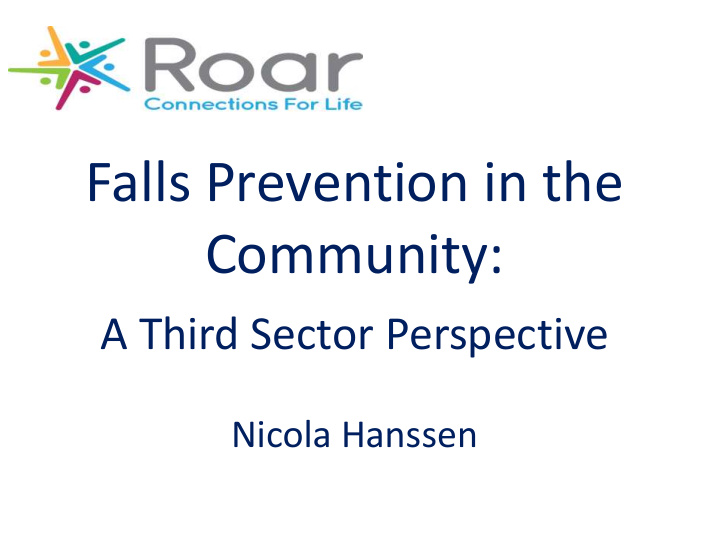



Falls Prevention in the Community: A Third Sector Perspective Nicola Hanssen
Roar’s vision is to connect lives & promote health and wellbeing in later life. Our charitable aims focus on reducing loneliness and social isolation Our determination to reduce falls and FRAILTY is inextricably linked to our vision and charitable aims
‘ Community’ Falls Prevention Can we look at a new approach to defining our people at risk of falling community? My definition is that if the person is already known to Health and Social Care/Statutory Services then they are yours. If the person is an aging member of the general public then they are community safety’s
#Stop1stFalls A whole system approach to community falls prevention 4 Themes 10 Elements Growing capacity and outcomes in Renfrewshire Scaling up would require a national joint communication strategy, national partnerships and a mixed funding solution
Campaigns
Level 2 Assessment Level 1 Assessment Level 3 Assessment “Level 1.5” Assessment and Intervention
Partnerships and Assessments Falls Stats per year… • 33% of people aged 65+ living in the community will fall • 50% of over-80s living in the community will fall. • 75% of falls-related deaths occur in the home. • 75% of falls are not reported. • Most falls occur when performing activities in the home. • Many falls could be prevented. • Poor lighting plus trip hazards are the most common cause Fire Stats per year… • 27% of casualties in house fires are people aged 65+ • 70% of fatalities in house fires were people over-65+ • 40% of fatalities in house fires were people over-80+ • 31% of house fires occurred where NO smoke alarm • 29% of house fires occurred where there WAS a smoke Alarm – BUT IT WASN’T WORKING ( accounting for 1/5 deaths
Partnerships and Assessments Assessing the interconnectivity between a person and their environment • Over half of falls experienced in the home are due to environmental hazards – e.g. trips, slips, unsafe or unlit stairs. A decline in a person’s intrinsic risk factors • (declining function and balance) means that the extrinsic risk factors (loose mat, slippery floor) no longer cause a correctable trip; they cause an injurious fall. • Many extrinsic risk factors may also lead to household fires and the Intrinsic risks will hamper the persons ability to escape. • Fear of falling (FOF) has a profound and largely detrimental effect on balance performance in older adults.
Services
Services
Services
Training
Training
Training
Training
Evaluations and Impact It is hugely challenging to prove that any single or combined community intervention has prevented someone from experiencing an injurious fall As a small organisation we have to balance the need to evidence the value of our approach with the investment of resource we would need to expend – and possibly still not sufficiently ‘prove’ the worth of our work But we do make a positive difference and we measure it in a range of ways.
Funding and Sustainability Speaking of Challenging…. If we accept a new definition of ‘community falls prevention’ then how should it be funded? Roar would like to be part of a national conversation about how we can scale up truly preventative Falls and FRAILTY prevention pathway that starts at the most fundamentally preventative self - management and community safety end of the spectrum supported by a mixed variety of social enterprises
Thank You Questions?
Recommend
More recommend